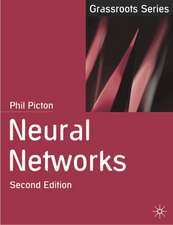Evolutionary Computations: New Algorithms and their Applications to Evolutionary Robots: Studies in Fuzziness and Soft Computing, cartea 147
Autor Keigo Watanabe, M.M.A. Hashemen Limba Engleză Hardback – 5 mar 2004
| Toate formatele și edițiile | Preț | Express |
|---|---|---|
| Paperback (1) | 635.31 lei 6-8 săpt. | |
| Springer Berlin, Heidelberg – 15 dec 2010 | 635.31 lei 6-8 săpt. | |
| Hardback (1) | 641.71 lei 6-8 săpt. | |
| Springer Berlin, Heidelberg – 5 mar 2004 | 641.71 lei 6-8 săpt. |
Din seria Studies in Fuzziness and Soft Computing
- 20%
 Preț: 999.85 lei
Preț: 999.85 lei - 20%
 Preț: 653.06 lei
Preț: 653.06 lei - 20%
 Preț: 872.96 lei
Preț: 872.96 lei - 20%
 Preț: 930.57 lei
Preț: 930.57 lei - 20%
 Preț: 1051.00 lei
Preț: 1051.00 lei - 20%
 Preț: 992.44 lei
Preț: 992.44 lei - 20%
 Preț: 655.85 lei
Preț: 655.85 lei - 20%
 Preț: 1001.86 lei
Preț: 1001.86 lei - 18%
 Preț: 954.14 lei
Preț: 954.14 lei - 20%
 Preț: 330.10 lei
Preț: 330.10 lei - 20%
 Preț: 333.04 lei
Preț: 333.04 lei - 20%
 Preț: 997.56 lei
Preț: 997.56 lei -
 Preț: 391.61 lei
Preț: 391.61 lei - 20%
 Preț: 647.79 lei
Preț: 647.79 lei - 20%
 Preț: 986.01 lei
Preț: 986.01 lei - 18%
 Preț: 958.56 lei
Preț: 958.56 lei - 20%
 Preț: 996.40 lei
Preț: 996.40 lei - 20%
 Preț: 999.35 lei
Preț: 999.35 lei - 15%
 Preț: 646.43 lei
Preț: 646.43 lei - 20%
 Preț: 651.57 lei
Preț: 651.57 lei - 20%
 Preț: 997.89 lei
Preț: 997.89 lei - 15%
 Preț: 641.03 lei
Preț: 641.03 lei - 20%
 Preț: 1009.74 lei
Preț: 1009.74 lei - 20%
 Preț: 992.62 lei
Preț: 992.62 lei -
 Preț: 388.72 lei
Preț: 388.72 lei - 18%
 Preț: 1223.43 lei
Preț: 1223.43 lei - 20%
 Preț: 651.42 lei
Preț: 651.42 lei - 18%
 Preț: 951.59 lei
Preț: 951.59 lei - 18%
 Preț: 948.61 lei
Preț: 948.61 lei
Preț: 641.71 lei
Preț vechi: 754.95 lei
-15% Nou
Puncte Express: 963
Preț estimativ în valută:
122.80€ • 127.43$ • 102.64£
122.80€ • 127.43$ • 102.64£
Carte tipărită la comandă
Livrare economică 15-29 martie
Preluare comenzi: 021 569.72.76
Specificații
ISBN-13: 9783540209010
ISBN-10: 3540209018
Pagini: 192
Ilustrații: XIX, 172 p.
Dimensiuni: 155 x 235 x 16 mm
Greutate: 0.45 kg
Ediția:2004
Editura: Springer Berlin, Heidelberg
Colecția Springer
Seria Studies in Fuzziness and Soft Computing
Locul publicării:Berlin, Heidelberg, Germany
ISBN-10: 3540209018
Pagini: 192
Ilustrații: XIX, 172 p.
Dimensiuni: 155 x 235 x 16 mm
Greutate: 0.45 kg
Ediția:2004
Editura: Springer Berlin, Heidelberg
Colecția Springer
Seria Studies in Fuzziness and Soft Computing
Locul publicării:Berlin, Heidelberg, Germany
Public țintă
ResearchCuprins
1. Evolutionary Algorithms: Revisited.- 1.1 Introduction.- 1.2 Stochastic Optimization Algorithms.- 1.3 Properties of Stochastic Optimization Algorithms.- 1.4 Variants of Evolutionary Algorithms.- 1.5 Basic Mechanisms of Evolutionary Algorithms.- 1.6 Similarities and Differences of Evolutionary Algorithms.- 1.7 Merits and Demerits of Evolutionary Algorithms.- 1.8 Summary.- 2. A Novel Evolution Strategy Algorithm.- 2.1 Introduction.- 2.2 Development of New Variation Operators.- 2.3 Proposed Novel Evolution Strategy.- 2.4 Proposed NES: How Does It Work?.- 2.5 Performance of the Proposed Evolution Strategy.- 2.6 Empirical Investigations for Exogenous Parameters.- 2.7 Summary.- 3. Evolutionary Optimization of Constrained Problems.- 3.1 Introduction.- 3.2 Constrained Optimization Problem.- 3.3 Constraint-Handling in Evolutionary Algorithms.- 3.4 Characteristics of the NES Algorithm.- 3.5 Construction of the Constrained Fitness Function.- 3.6 Test Problems.- 3.7 Implementation, Results and Discussions.- 3.8 Summary.- 4. An Incest Prevented Evolution Strategy Algorithm.- 4.1 Introduction.- 4.2 Incest Prevention: A Natural Phenomena.- 4.3 Proposed Incest Prevented Evolution Strategy.- 4.4 Performance of the Proposed Incest Prevented Evolution Strategy.- 4.5 Implementation and Experimental Results.- 4.6 Summary.- 5. Evolutionary Solution of Optimal Control Problems.- 5.1 Introduction.- 5.2 Conventional Variation Operators.- 5.3 Optimal Control Problems.- 5.4 Simulation Examples.- 5.5 Results and Discussions.- 5.6 Summary.- 6. Evolutionary Design of Robot Controllers.- 6.1 Introduction.- 6.2 A Mobile Robot with Two Independent Driving Wheels.- 6.3 Optimal Servocontroller Design for the Robot.- 6.4 Construction of the Fitness Function for the Controllers.- 6.5 Considerations for Design and Simulations.- 6.6 Results and Discussions.- 6.7 Summary.- 7. Evolutionary Behavior-Based Control of Mobile Robots.- 7.1 Introduction.- 7.2 An Evolution Strategy Using Statistical Information of Subgroups.- 7.3 Omnidirectional Mobile Robot.- 7.4 Fuzzy Behavior-Based Control System.- 7.5 Acquisition of Control System.- 7.6 Summary.- 8. Evolutionary Trajectory Planning of Autonomous Robots.- 8.1 Introduction.- 8.2 Fundamentals of Evolutionary Trajectory Planning.- 8.3 Formulation of the Problem for Trajectory Planning.- 8.4 Polygonal Obstacle Sensing and Its Representation.- 8.5 Special Representations of Evolutionary Components.- 8.6 Construction of the Fitness Function.- 8.7 Bounds for Evolutionary Parameters.- 8.8 Proposed Evolutionary Trajectory Planning Algorithm.- 8.9 Considerations and Simulations.- 8.10 Results and Discussions.- 8.11 Summary.- A. Definitions from Probability Theory and Statistics.- A.1 Random Variables, Distributions and Density Functions.- A.2 Characteristics Values of Probability Distributions.- A.2.1 One Dimensional Distributions:.- A.2.2 Multidimensional Distributions.- A.3 Special Distributions.- A.3.1 The Normal or Gaussian Distribution.- A.3.4 The Cauchy Distribution.- B. C-Language Source Code of the NES Algorithm.- C. Convergence Behavior of Evolution Strategies.- C.1 Convergence Reliability.- C.2 Convergence Velocity.- References.
Textul de pe ultima copertă
Evolutionary Computation, a broad field that includes Genetic Algorithms, Evolution Strategies, and Evolutionary Programming, has proven to offer well-suited techniques for industrial and management tasks - therefore receiving considerable attention fom scientists and engineers during the last decade. This monograph develops and analyzes evolutionary algorithms that can be successfully applied to real-world problems such as robotic control. Although of particular interest to robotic control engineers, "Evolutionary Computations" also may interest the large audience of researchers, engineers, designers and graduate students confronted with complicated optimization tasks.
Caracteristici
Presents evolutionary algorithms that can be successfully applied to real-world problems such as robotic control Basic understanding of mathematics is sufficient to follow the book Includes supplementary material: sn.pub/extras


















